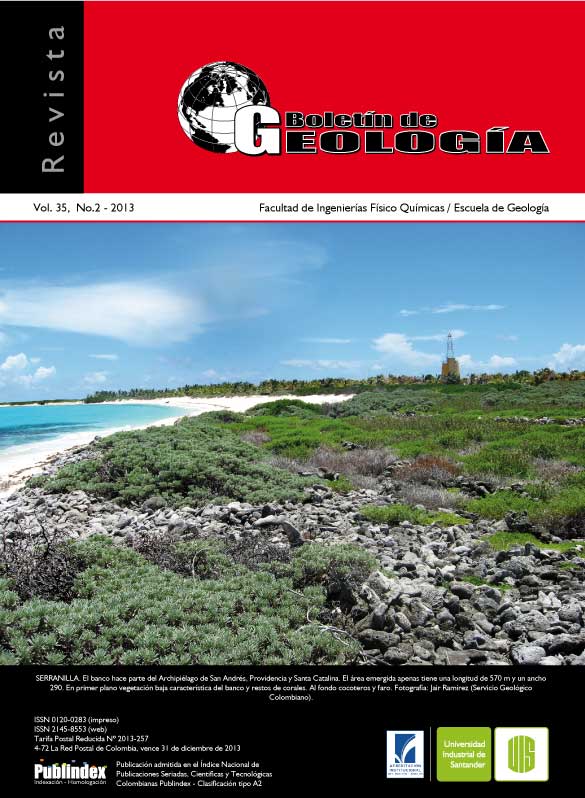HYDROCARBON PROSPECTIVITY IN THE VAUPES-AMAZONAS BASIN, COLOMBIA
Published 2013-12-12
Keywords
- Hydricarbon,
- Prospectivity,
- Shales,
- Gas,
- Vaupés
- Amazonas,
- Geochemistry,
- Seísmic ...More
How to Cite
Abstract
The assessment of hydrocarbon prospectivity in the Vaupés-Amazon Basin frontier with an area of 155,000 km^2 indicates that the southern area presents the highest gas potential, and that is also related with the oil and gas potential in the Solimöes Basin in Brazil. The potential hydrocarbon reservoirs are related to compressive structures, which were identified in seismic lines of the Vaupes-Amazonas Basin, and formed during the Hercinian orogeny. The Geochemical models indicate that hydrocarbons were generated in the organic-rich Devonian shales in the late Permian and migrated later in the early Mesozoic. High TOC contents and high maturity maturation levels found in the Devonian organic-rich shales in the Solimöes Basin, indicate that the Vaupés-Amazon Basin may also have a potential for unconventional deposits of shale gas type.
Downloads
References
Alemán, A. 1988. Geological Reconnaissance of the Eastern Segment of the Leticia Block, Amoco. ECOPETROL, Informe interno, 2084.
Barrero, D., Pardo, A., Vargas, C. and Martínez, J. 2007. Colombian sedimentary Basins: Nomenclature, boundaries and petroleum geology, a new proposal, ANH, 91p.
Bogotá, R.J. 1983. Estratigrafía del Paleozoico inferior en el área Amazónica de Colombia, Geología Norandina, 6: 29-38.
Briceño, L.A., Rey, C., Vargas, C.A., Hernández, O., and Zamora, A. 2008. New Gravity Map of Colombia, CBAM-2008. In: Earth Sciences Research Journal, 12, Special ed.: 13-22. Disponible en www.anh.gov.co.
Cediel, F., Etayo, F., y Cáceres, C. 2003. Mapas de distribución de facies sedimentarias y armazón tectónico de Colombia a través del Proterozoico y del Fanerozoico. INGEOMINAS.
Córdoba, F., González, J.A., Meneses, H., y Ruge, P. 1992. Proyecto 15. Ríos Guaviare 92 Cuenca Amazonas, Configuración y modelo geotécnico preliminar de la cuenca. Informe de compilación y evaluación de la información técnica. Bogotá: ECOPETROL, Informe interno 3360.
Da Cruz Cunha, P.R., Braga da Silva, O., y Fernández,E. J. 1988. Interpretación facial y ambiental de los principales reservorios de hidrocarburos de la cuenca Solimöes-Area. XXXV. Congreso Brasileiro de Geología, 6: 1 - 2441.
Etayo, F., Barrero, D., Lozano, H. Espinosa, A., González, H., Orrego, A., Ballesteros, I., Forero, H., Ramírez, C., Zambrano, F., Duque, H., Vargas, R., Núñez, A., Álvarez, J., Ropain, C., Cardoso, E.,
Galvis, N., y Sarmiento, L. 1983. Mapa de terrenos geológicos de Colombia. Publicaciones Especiales del INGEOMINAS, 14: 1-235.Galvis, V.J., Huguett, G., y Ruge, P. 1979. Geología de la Amazonía colombiana. Boletín Geológico, INGEOMINAS, 22 (3): 3-86.
Gonzaga, F.G., Coutinho, L.F., and Goncalves, F.T.T. 2000. Petroleum Geology of the Amazonas Basin, Modeling of Hydrocarbon generation and Migration. En: Mello M.R., and B.J. Katz, edts. Petroleum systems of South Atlantic margins: AAPG Memoir 73: 159-178.
Herrera, A., y Velásquez, B.E. 1978. Estratigrafía de la sección de Araracuara (Amazonía), Tesis de Grado, Universidad Nacional de Colombia, Bogotá.
